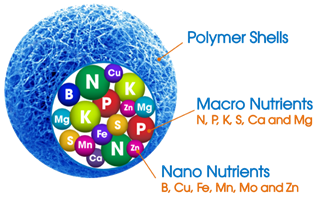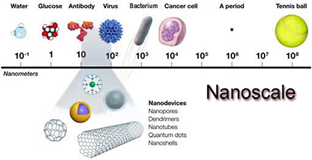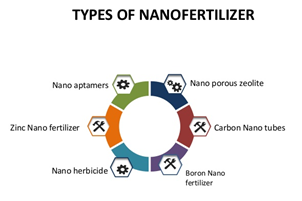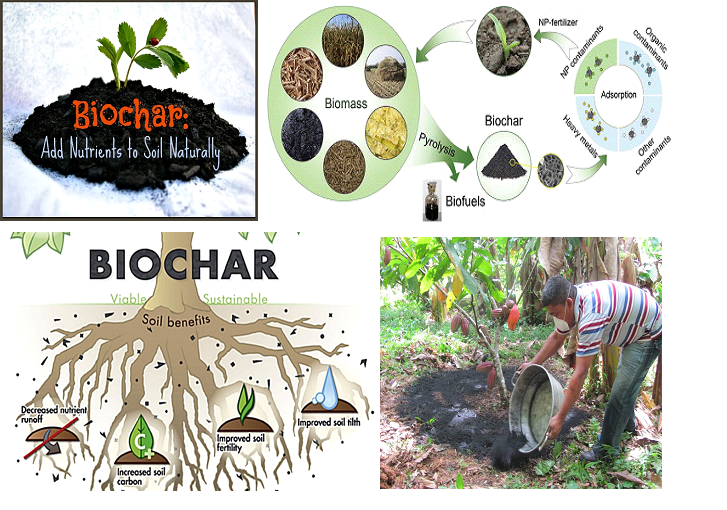Ranjan Paul1, Sonalika Sahoo2, Abir Dey 3 and Gobinath, R4
1 Division of Soil Resource Studies, ICAR-National Bureau of Soil Survey and Land Use Planning, Amravati Road, P.O. University Campus, Nagpur-440033.
2 Division of Environmental Soil Science, ICAR-Indian Institute of Soil Science, Bhopal-462038.
3 Division of Soil Science and Agricultural Chemistry, ICAR-Indian Agricultural Research Institute, New Delhi-110012.
4 ICAR-Indian Institute of Rice Research, Hyderabad, Telangana-500030
Corresponding author e-mail address: abirdey21@gmail.com
Introduction
In forthcoming decades, there will be immense burden on global food production system to accomplish the herculean task of providing food security to an ever-growing world population, without impacting environmental quality. Green revolution in the past was a successful attempt to curb world hunger and provide food security to all. But what followed the green revolution is an over use or rather abuse of chemical fertilizers without any check, which led to several negative impact on environment. Imbalanced nitrogen (N) fertilizer application leads to accelerated acidification of soil, multi-nutrient deficiency due to preferential application of single nutrient chemical fertilizers and a decline in soil organic matter. It also results in low plant acquisition efficiency and subsequent nitrate and phosphate leaching causing eutrophication of freshwater and estuaries, volatilization losses of N in the form of ammonia and nitrous oxide (N2O). Another deadlier aspect of todays’ intensive cultivation is accelerated green-house gas (GHG) emission contributing up to 20% to the annual atmospheric emissions of GHG. The main forms of agriculture related GHG emissions comprises of methane, carbon dioxide and N2O. The GHG emission from farm plots originates from low N use efficient fertilizers, excessive fossil fuel burning for mechanical operation and more importantly ill management of crop residues in intensively cultivated cereal-cereal systems leading to straw burning which for example presently suffocating the Northwestern parts of India for past few years.
In order to combat all the above said obstacles, efficient input management in agriculture is the silver bullet. New types of smart fertilizers with controlled nutrient release are needed, which could enhance nutrient use efficiency through synchronization of nutrient availability with the plant demands. This way nutrient losses to the surroundings would be curbed down along with the environmental pollution. Economically viable crop residue management should be devised, so that farmers should not burn them. To mitigate the global GHG emissions, agricultural soils should be used as sinks for C sequestration through best management practices. The use of smart fertilizers or rather smart input management should be directed to the economic benefit of end users, i.e. farmers for better adaptability. Then only we can achieve a sustainable agriculture which can feed our next generations without harming the environment. In the following article some of new fertilizer materials are discussed which have a potential in this context.
Synthetic polymers
Synthetic polymers are widely used in agriculture especially for fertilizer development (Fig.1). Smart polymeric materials have been applied to smart delivery systems of a wide variety of agrochemicals also. A range of petroleum-based polymers viz., polysulfone, polyacrylonitrile, polyvinyl chloride, polyurethane, polystyrene etc. have been used to encapsulate water-soluble fertilizers. Physical properties of the coatings influence the release rate of encapsulated nutrients. These polymers are biodegradable, thus safe for environment. The polymers are categorized in two groups according to water vapor permeability (K). Biopols, polylactic acids, and polycaprolactone belongs to first category (K<3000 cm2 S-1 Pa -1) and modified polysaccharides (alginates, starches, agar) to the second (K>3000 cm2 S-1 Pa-1). These polymers coating imparts slow release characteristics to the fertilizer material, which solubilizes nutrient in synchrony with plant demand. Thus, nutrient use efficiency can be improved along with reduction in environmental pollution related to nutrient loss.

Fig 1. Synthetic polymeric material for nutrient delivery to soils
Nanofertilizers
Nanofertilizers involves the materials at nanoscale level, ranging from 1 to 100 nm (Fig 2). There are three main types of nano-fertilizers (Fig. 3): nanoscale fertilizer (synthesized nanoparticles), nanoscale additives (bulk products with nanoscale additives), and nanoscale coating or host materials (product coated with nanopolymer or loaded with nanoparticles). Slow-release nano-fertilizers are suitable alternatives to soluble fertilizers. The mineral nutrients required for plant nutrition can be encapsulated inside nanomaterials such as nanotubes or nanoporous materials, coated with a thin protective polymer film, or nanoscale particles. Nutrients are released at a slower rate during crop growth, thereby reducing loss and increasing nutrient use efficiency. Synthetic or natural nanoparticles obtained from various sources, including plants, soils, and microorganisms can be used. Naturally occurring nano-clays, in this regard is considered very important and cost effective nano-material. Nanocomposites on the other hand is a hybrid material, consisting of a continuous polymer phase or matrix and a dispersed nano-filler phase. The dispersion of a small amount (<10%) of nanomaterial in the polymer matrix can lead to marked improvement in physical and mechanical properties (strengths, pH tolerance, storage stability, heat distortion, break elongation) compared with a single polymer matrix. This nanocomposites can be used as nutrient source or as a coating and cementing material facilitating slow and synchronized nutrient release. Therefore, the future development should focus on materials allowing for nutrient release from nanofertilizers triggered by an environmental condition or simply at specific time. In this context, nanodevices or additives (e.g., nanotubes, aptamers, double hydroxide nanocomposites, urease enzymes, nanosize titanium dioxide, nanosilica particles) can be associated to nanofertilizers to synchronize the fertilizer release with plant demand.

Fig 2. Size of Nanomaterials

Fig 3. Types of Nanofertilizers
Crop residues
The menace of burning crop residues can be reverted back by using these residues for smart fertilizer formulations. The residues contain lignin, hemicelluloses, and cellulose, which can impart mechanical strength to formulations. Wheat straw is an abundant source of carboxyl, hydroxyl, ether, amino, and phosphate groups useful in the preparation of adsorbent materials for slow-release fertilizers with enhanced reactivity. Potential use of wheat straw for the development of slow-release N and boron fertilizers with water-retention properties has been well known. Cellulose obtained from agricultural residues has been also used in bioformulations as carrier for bacterial inoculants with broad spectrum antifungal activity and suppression of fungal pathogens. Lignocellulose and compost are subject to rapid decomposition once incorporated into soil. In order to further improve their properties as slow-release fertilizers, they could be combined with clay minerals or biochar to reduce their decomposition.
Biochar
Field crop residues as well as by-products from paper, pulp and wood industries can be used as feedstock for energy producing pyrolysis systems which generates biochar or pyrogenic carbon as a by-product (Fig 4). Bio-char has been widely used to increase C sequestration. Biochar produced from corncob, banana stalk, and pomelo peel displayed an excellent retention ability in holding NH4+ associated to the presence of carboxyl and keto groups when the material was prepared at 200°C, suggesting that this material could be used as a slow-release carrier for N. Biochar addition to soils also reported to have positive effects on water-holding capacity. The use of biochar as carrier for smart fertilizers could be highly beneficial, as it combines nutritional benefits for plants with improvement of many other soil functions due to the addition of biochar itself.

Fig 4. Biochars as source of nutrients for plants
Conclusion
Despite continuing technological developments and the commercial availability of smart fertilizers, their use in agriculture is very limited, less than 1% of the total worldwide fertilizer consumption. The main reason for their limited use is the high cost, which may be eight to twelve times higher than a corresponding standard fertilizer. However, several advantages could be observed for smart fertilizer in comparison with conventional fertilizers. The combination of superabsorbent polymers/biochar and fertilizer can improve the water-holding and water-retention behavior of soil, having potential to reduce the consumption of irrigation water, which makes sure the as-prepared fertilizers, could be used in arid regions. The introduction of biodegradable macrocross-linker would improve the degradability property since the application of fertilizer into soil. In addition, smart fertilizers could promote nutrient absorption by crops and enhance fertilizer use efficiency during the growing season. Compared with conventional uncoated urea fertilizer, the multifunctional environmental smart fertilizer can sustain release nutrients, which can significantly reduce the costs of repeated application. On the other hand, smart fertilizers would reduce losses of nutrients, prolong fertilizer cycles, and enhance effective nutrient uptake by crops. These can substantially decrease the risk of environmental pollution. Taking into account these economic aspects and the extremely important environmental aspects, the use of smart fertilizers in modern agriculture would benefit farmers, and is also good for the protection of the environment, which may be enough to outweigh the cost.
About Author / Additional Info:
Abir Dey completed his M.Sc. and Ph.D. Degree from Division of Soil Science and Agricultural Chemistry, ICAR-Indian Agricultural Research Institute (IARI), New Delhi in the year 2011 and 2017, respectively. During his M.Sc. he was getting ICAR Junior Research Fellowship followed by ICAR Senior Research Fellowship, IARI merit scholarship and UGC Junior Research Fellowship during his Ph.D. tenure. He received Indian Society of Soil Science (ISSS) Zonal Award (North Zone) for best presentation of M.Sc. Dissertation. He received The Golden Jubilee Award for Outstanding Doctoral Research in Fertilizer Usage by Fertiliser Association of India and ISSS- Commendation Certificate for Best Presentation of Doctoral Research Work done in Soil Science. He published 08 research/review papers in several reputed national/international journals. He also co-authored in 03 book chapters. Currently he is working as an Agricultural Research Scientist in the Division of Soil Science and Agricultural Chemistry, ICAR-IARI, New Delhi. His current research areas are conservation agriculture, soil carbon dynamics, and quality of soil organic matter, soil fertility and plant nutrition.